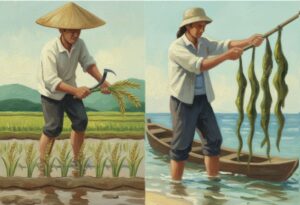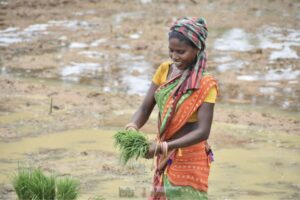
From being a heavy rice importer in the 1970s, Indonesia today is the third-largest rice producer in the world, and has been consistently so since the 1970s. From 1970 to 2006, Indonesia’s average rice yield rose by more than 95% from 2.35 tons per hectare to 4.62 tons per hectare. Most of Indonesia’s rice-producing areas are on the island of Java, home to more than half of Indonesia’s population. Jakarta, the capital, is located in West Java.

To attain higher rice production, Indonesia had to develop and deploy new varieties of rice and adopt crop management technologies. The Indonesian government also played a significant role in the process, helping the country achieve consistent annual growth in rice production until it became self-sufficient in 1984. For one, government policies stabilized prices for urban consumers and expanded domestic output by disseminating high-yielding varieties (via government extension programs), fertilizer subsidies, and investment in irrigation infrastructure.
Today, Indonesia is the 7th most populous country in the world. A population increase of 1.5% per year requires a corresponding increase in food supply. It is in this context that Indonesia’s agricultural development program aims to (1) increase national food security through higher food production and lower food imports, (2) increase value added to and competitiveness of agricultural products, and (3) improve quality of life and lessen poverty for farming households through high productivity.
IRRI and Indonesia
The Indonesian government recognizes the importance of research and technology in national development. The International Rice Research Institute (IRRI) and Indonesia formally started collaborating in December 1972.
This partnership was hatched when both parties agreed to cooperate on the improvement of rice research through the country’s National Rice Research Program. The highest priority was given to the genetic evaluation and use of rice, the implementation of improved rice-based cropping systems, development and testing of machinery for small-scale farming, and training of Indonesian scientists.
Genetic diversity
IRRI conserves in its International Rice Genebank 9,001 Indonesian rice accessions, including lowland, upland, and tidal swamp varieties. National research centers in Indonesia are also exploring the potential of the country’s traditional types of rice in generating new, improved varieties.
Future collaboration
Indonesia and IRRI developed a four-year work plan at a meeting held in Jakarta in January 2011. While both parties agreed that previous areas of collaboration will continue, they also concurred to focus on the following in the next 4 years:
- Varietal development to mitigate the effects of climate change;
- A national strategy for hybrid rice development;
- Research on abiotic stresses, particularly submergence, drought, salinity, and low-temperature damage in high-elevation areas;
- Support to implement integrated crop, pest, and resource management;
- Support to disseminate proven technologies, including postharvest technologies; and
- Support for socioeconomic policy research
_________________________________
Ms. Baroña is a Science Communication Specialist at the International Rice Research Institute









